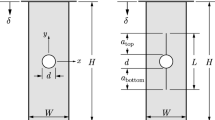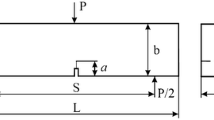We show a correlation between the loading characteristic of crack resistance (critical stress intensity factor) and the mechanical characteristics during dynamic indentation. We propose a procedure for monitoring a material in the stage preceding its fracture. We have obtained experimental results for isotropic pyrolytic graphite that support the feasibility of the procedure and the possibility of using it for nondestructive testing of graphitized carbon materials.



Similar content being viewed by others
References
J. A. Collins, Failure of Materials in Mechanical Design: Analysis, Prediction, Prevention [Russian translation], Mir, Moscow (1984).
V. V. Moskvichev et al., Crack Resistance of Construction Materials in Engineering Systems, Nauka, Novosibirsk (2002).
GOST 25.506-85, Strength Calculations and Tests. Mechanical Testing Methods for Materials. Determination of Crack Resistance (fracture toughness) Characteristics under Static Loading.
ASTM E 1820-06, Standard Test Method for Measurement of Fracture Toughness.
ISO 17281:2002, Plastics – Determination of Fracture Toughness (G1C and K1C) at Moderately High Loading Rates (1 m/s).
ISO 11673:2005, Unplasticized Poly(vinyl chloride) (PVC-U) Pressure Pipes – Determination of the Fracture Toughness Properties.
A. V. Bashta, “Studies of a ceramic during indentation by a Vickers diamond pyramid,” Probl. Prochn., No. 9, 49–54 (1990).
A. P. Kren’, “Determination of the critical stress intensity factor of glass under elastic contact conditions by the dynamic indentation method,” Probl. Prochn., No. 6, 51–60 (2009).
A. P. Kren’, “Nondestructive testing for crack resistance of elastoplastic materials using local contact loading parameters,” Vesti NAN Belarusi, No. 3, 117–121 (2011).
D. A. Chernous et al., “Procedure for determining viscoelastic characteristics of rubber blends by dynamic indentation,” Zavod. Lab. Diagn. Mater., 75, No. 12, 50–53 (2009).
V. A. Rudnitskii and A. P. Kren’, Testing Elastomer Materials by Indentation Methods, Belorusskaya Nauka, Minsk (2007).
ISO 13586:2000, Plastics – Determination of Fracture Toughness (G1C and K1C) – Linear Elastic Fracture Mechanics (LEFM) Approach.
A. A. Khlybov, “Study of accumulation of isolated microdamage in specimens of 08Kh18N10T steel during low-cycle fatigue,” Kontrol. Diagnost., No. 4, 55–61 (2011).
Yu. S. Bakhracheva, “Evaluation of fracture toughness in steels from contact deformation results,” Tekhn.-Tekhnol. Innov. Vestnik Volgograd. Gos. Univ., Ser. 10, No. 7, 53–56 (2012).
M. Ya. Marusina and A. V. Flegontov, “Applications of dimensional analysis and group theory in mechanics,” Nauch. Priborostr., 15, No. 1, 94–99 (2005).
M. Ya. Marusina, Invariant Analysis and Synthesis in Models with Symmetries, Izd. SPbGU ITMO, St. Petersburg (2004).
Author information
Authors and Affiliations
Corresponding author
Additional information
Translated from Metrologiya, No. 11, pp. 25–32, November, 2014.
Rights and permissions
About this article
Cite this article
Marusin, M.P., Fedorov, A.V., Kren’, A.P. et al. Determination of the Crack Resistance Characteristics of Graphitized Carbon Materials by the Dynamic Indentation Method. Meas Tech 57, 1411–1415 (2015). https://doi.org/10.1007/s11018-015-0642-1
Received:
Published:
Issue Date:
DOI: https://doi.org/10.1007/s11018-015-0642-1




